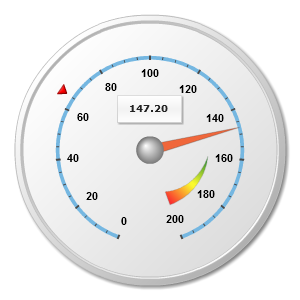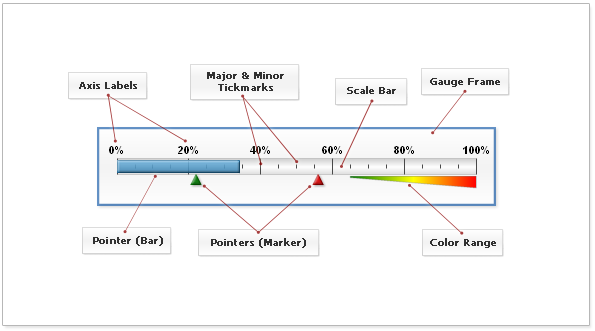Gauges Architecture
Overview
In this short article we will show the parts of Gauges, so you can understand what you need to change or edit when creating your own gauges.
Although circular an linear gauges share almost the same terms - the have differences, so the description is split into two parts. Each description contain a scheme that demostrates each component of a gauge, live sampl and a list of configurable parts.
Circular Gauge
Circular Gauge looks like gauges on a car dashboard. It consists of radial scale, holding your data range, pointer, and might support different color ranges for classifying your data. Gauges can be not only circular, but also semi-circular, actually - AnyChart supports any angle ranges.
Circular gauge can have several pointers of a different types, several color ranges, several axes with configurable scale, axis markers and so on. Please study an image below to see the basic parts of circular gauge.
Circular Gauge Scheme

Circular Gauge Sample
The sample below reproduces the gauge from the scheme above, all major nodes are included - you can launch the live sample and view its XML.

Circular Gauge Configuration Waypoints
Now, when you know main parts you can learn about all options of all elements, please choose an element and study an appropriate tutorial:
Linear Gauge
The Linear Gauge is a slider, or a wide line, that can hold much information and possess a variety features. It can be either vertical or horizontal, have any width of the line and use a single or multiple pointers to show your data value.
Linear gauge can have several pointers of a different types (although some of them are hardly compatible), several color ranges, several axes with configurable scale, axis markers and so on. Please study an image below to see the basic parts of linear gauge. The only difference between vertical and horizontal linear gauge is the orientation attribute, we will demostrate everything using horizontal one.
Linear Gauge Scheme

Linear Gauge Sample
The sample below reproduces the gauge from the scheme above, all major nodes are included - you can launch the live sample and view its XML.

Linear Gauge Configuration Waypoints
Now, when you know main parts you can learn about all options of all elements, please choose an element and study an appropriate tutorial:
- Your First Gauge - Horizontal / Vertical
- Axis - Horizontal / Vertical
- Scale - Horizontal / Vertical
- Pointers - Horizontal / Vertical
- Color Ranges - Horizontal / Vertical